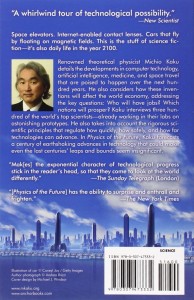The Future is now! Review of Physics of the Future by Michio Kaku
Since I was a child, I have always been fascinated by technology and imaginary worlds. This led to a love of science-fiction and at the same time earned me the nerd tag. Within science-fiction, some works are specifically predicting what our world will look like 50 or a hundred years from now. Examples are Jules Verne’s Paris in the Twentieth Century, 2001 a Space Odyssey by Arthur C. Clarke or Neuromancer by William Gibson. These books take you on a daydreaming trip about what the future holds. I love daydreaming, do you?
In this light, Physics of the Future is a fascinating book. It is not a science-fiction novel per se, but a scientific essay at depicting what our world will become in the next 100 years, with a focus on science and technology. It draws inspiration from state of the art research currently under way in several fields. Predictions are made based on thorough research and solid current evidence.
To see what other people think of the book on Amazon, click HERE.
It is not a novel, it doesn’t contain a fiction story. It is a review of current technologies and a drawing of the future’s picture based on them. Reading the book takes you on a fantastic voyage to the future, that is absolutely fascinating.
The author, Michio Kaku, is an American futurist, theoretical physicist and the author of several international best-selling books, such as Beyond Einstein, Hyperspace and Physics of the Impossible. He has also appeared on many TV programs. He is therefore a seasoned writer in the field of physics and futurist discussions. Basically, we are in good hands here.
Content
Physics of the Future is separated in 3 periods:
1. Near future (present to 2030)
2. Midcentury (2030-2070)
3. Far future (2070-2100)
And for each area of technology, the three periods above are covered. The areas covered in the book are:
- Computers
- AI
- Medicine
- Nanotechnology
- Energy
- Space travel
- Wealth
- Humanity
 Each field is covered in details over the 370 pages of content and predictions are generally not far-fetched. Some of the science and technology placed in the near future period is in fact already there (e.g. Google glass). As a reader you will discover or re-discover technology in all the different areas listed above that is already in the research or even development phase. This is the case for the near future period and in some cases for the midcentury period. From this base are drawn predictions for the far future. As you can see, on this basis, predictions are not too crazy. This is what makes this book a step above similar works.
Each field is covered in details over the 370 pages of content and predictions are generally not far-fetched. Some of the science and technology placed in the near future period is in fact already there (e.g. Google glass). As a reader you will discover or re-discover technology in all the different areas listed above that is already in the research or even development phase. This is the case for the near future period and in some cases for the midcentury period. From this base are drawn predictions for the far future. As you can see, on this basis, predictions are not too crazy. This is what makes this book a step above similar works.
The only drawback in predictions is that the likeliness of commercial success of each technology is not analyzed critically enough. The author tells us that he disregards technology that is not social per se. He sees humans as gregarious creatures and argues that technology that isolates us won’t be successful. The success of future technology is then passed through this sieve. It’s a good first step to separate between technologies that have a future and the ones that haven’t.
However, it is a rough sieve. A more refined one is needed to check whether a specific technology is going to be successful or not. Taking the example of Google glass that is covered in the book, we can see with hindsight that it wasn’t a successful technology (even though it looks like it’s due for a comeback soon). The main reason is that the added value of the glasses couldn’t counter-balance the “uncool” fashion statement of wearing them. This is an example of a filter for promising technology: are people going to be willing to wear it? Is it too cumbersome? Another filter is how user friendly the technology is. With hindsight, it is much easier to see what worked and what hasn’t. However, I would have wished for a more aggressive filtering of upcoming technology to depict the world of tomorrow.
Style
The writing style is clear and accessible. Michio does a good job of explaining complex science in simple terms. It is a pleasure to read through all the great content. One downside is that the style is slightly too academic, but it’s not a real issue.
Conclusion
Physics of the Future is a brilliant book and a must read if you are interested in cutting edge technology and science. It is also a fascinating read for any fan of science fiction. Finally, if you are looking at investing into up and coming technology and companies, it is definitely an inspiring read.
Physics of the Future gets my wholehearted recommendation.
Summary
Pros
Based on thorough research
Fascinating content
Cutting edge science and technology
Cons
Limited business analysis of each technology
Style: 4/5
Content: 5/5
Number of pages: 390
Amazon price: Paperback: $9.05/£7.99, Kindle: $10.60/£6.85
To buy the book, click HERE (US) or HERE (UK).
The Future is now! Review of Physics of the Future by Michio Kaku | techynews2015
May 23, 2015